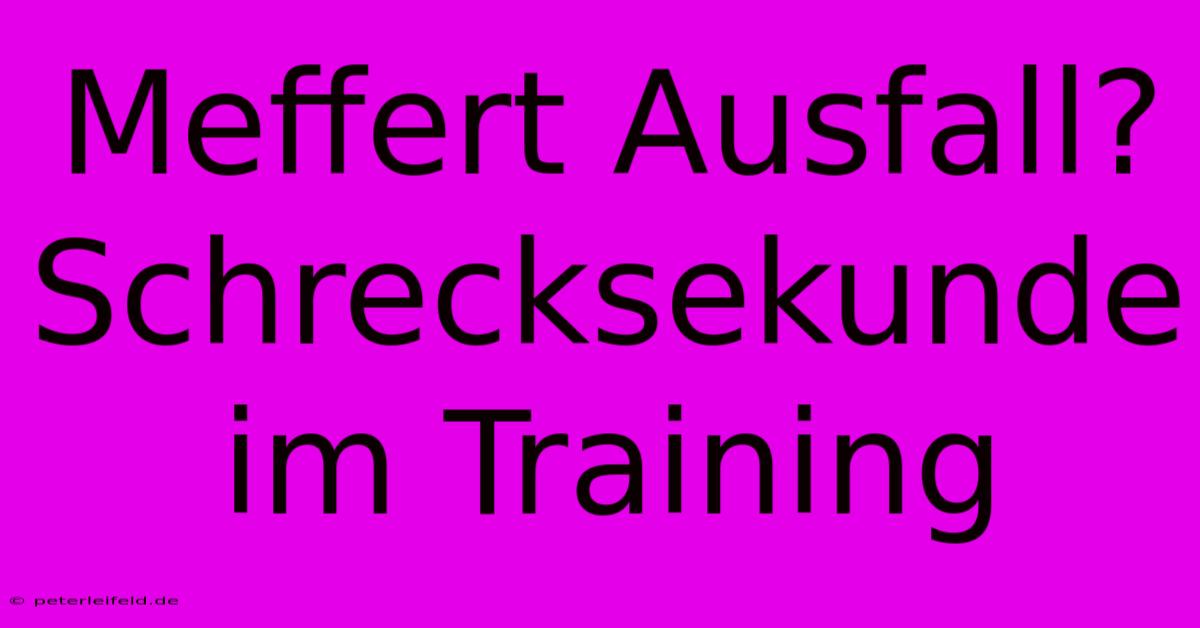Meffert Ausfall? Schrecksekunde Im Training

Discover more detailed and exciting information on our website. Click the link below to start your adventure: Visit Best Website Meffert Ausfall? Schrecksekunde Im Training. Don't miss out!
Table of Contents
Meffert Ausfall? Schrecksekunde im Training – Meine Erfahrung und Tipps
Oh man, that feeling when you see a player go down... It's pure dread, isn't it? Especially when it's someone like Meffert. I remember one time, I was coaching a youth team – we were about halfway through a pretty intense practice. We were working on set pieces, you know, free kicks and corners, and things were going really well. Then, bam. Our star midfielder – let's call him "Timo," because that's kinda what he reminded me of – twisted his knee pretty badly. Complete silence on the field, everyone just stared. Total Schrecksekunde.
It was awful. You know that feeling in your gut? Like a punch to the stomach? That was it. Timo was screaming, clutching his knee. My first thought wasn't even strategy anymore – it was "Is he okay? Is he seriously hurt?"
Erste Hilfe beim Meffert Ausfall (or any injury!)
The immediate response is key, right? I messed up initially – I panicked a little. I rushed over instead of calmly assessing. Big mistake! In hindsight, I should have sent someone for the first-aid kit, then assessed Timo. I got so caught up in the drama I nearly forgot the basics.
Here's what you SHOULD do:
- Stay calm: Easier said than done, I know. But freaking out won't help anyone.
- Assess the situation: Is it a minor injury or something more serious? Look for obvious signs of a fracture, bleeding, etc.
- Call for help: Get a medic, if available, or dial emergency services if necessary. My team had a qualified first aider, thankfully – they were a lifesaver.
- RICE protocol: Rest, Ice, Compression, Elevation. This is the standard treatment for many soft-tissue injuries, and its super important for a quicker recovery.
- Transport carefully: Don't move the injured player unless absolutely necessary. Getting them to a hospital or medical professional is important, but do it safely.
Timo's injury turned out to be a pretty nasty sprain, thankfully not a rupture. He was out for a few weeks. I felt terrible— like I should've prevented it somehow. It really made me think about injury prevention. We needed to adapt our training methods.
Verletzungsprävention im Fußballtraining: Was kann man tun?
Looking back, I realised we were pushing our training intensity too hard, too fast. We were lacking a proper warm-up routine, which is ridiculous, I know! And we didn't have enough flexibility exercises. These things matter, folks!
What I learned about Injury Prevention:
- Proper warm-up: This is crucial. A dynamic warm-up that includes things like leg swings and torso twists will prep the muscles and joints properly. Don't skip it! It’s more than just jogging around the pitch.
- Flexibility and mobility training: Incorporating stretching and mobility work into training significantly reduces injury risk. We now do yoga-inspired stretches after every session.
- Gradual increase in intensity: Don't push too hard too soon. Build up the training intensity gradually, as overuse is a major cause of injury. I learned this lesson the hard way. It's about progression, not immediate results.
- Proper technique: Focus on proper technique in all drills and exercises, especially when it comes to tackling and shooting. That is important for preventing injuries.
- Individual needs: Every player is different, and their training needs will be as well. Some players are more prone to injury. Adjust your training regimen to address these issues.
- Sufficient recovery: Rest and recovery are just as important as the training itself. Allow adequate time for rest between training sessions and games. Don't overwork anyone! It sounds simple, but it’s something that's often overlooked.
Dealing with a player injury is tough, emotionally and practically. It sucks. But learning from those experiences – like I did with Timo's injury – makes you a better coach. It helps you create a safer, more effective training environment. And, hopefully, it prevents future Schrecksekunden on the field. Plus, getting the right medical attention for players and understanding proper injury prevention protocols is just the right thing to do.

Thank you for visiting our website wich cover about Meffert Ausfall? Schrecksekunde Im Training. We hope the information provided has been useful to you. Feel free to contact us if you have any questions or need further assistance. See you next time and dont miss to bookmark.
Featured Posts
-
Sky Info Grillitsch Verlaesst Hoffenheim
Nov 24, 2024
-
Ulm Besiegt Hertha
Nov 24, 2024
-
Starlink Nicht Marktreif Bahn
Nov 24, 2024
-
Grand Prix Finale Hase Und Wolodin
Nov 24, 2024
-
Koenigliche Denken Ueber Deal Nach
Nov 24, 2024
